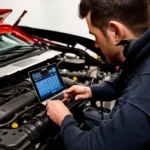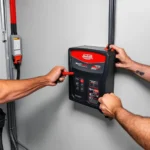Have you ever been driving down a California highway, maybe cruising along the Pacific Coast Highway, and suddenly your diesel engine starts acting up? Loss of power, rough idling – the works! It could be your ICP (Injection Control Pressure) sensor throwing a wrench in your road trip plans. But before you start panicking and calling for a tow to the nearest mechanic in San Francisco, let’s learn how you can use a scan tool to diagnose the problem yourself.
Understanding the Importance of ICP Pressure
Before we dive into the “how-to,” let’s talk about why ICP pressure is so important for your diesel engine.
The Heart of Your Diesel Engine
Think of ICP pressure as the lifeblood of your diesel engine’s fuel injection system. It’s responsible for ensuring the precise amount of fuel is injected into the cylinders at the right time. When this pressure is off, your engine’s performance takes a hit.
Why Testing Matters
Testing your ICP pressure with a scan tool can help you pinpoint the root cause of various engine problems, such as:
- Hard Starting: If your engine struggles to turn over, low ICP pressure might be the culprit.
- Rough Idling: Unstable idle speeds can often be traced back to faulty ICP sensors or related components.
- Loss of Power: Notice a decrease in engine power? ICP pressure problems could be to blame.
- Black Smoke: Excessive black smoke from your exhaust can indicate an issue with fuel injection timing, potentially linked to the ICP system.
Diagnosing with a Scan Tool: A Step-by-Step Guide
Now, let’s get down to business. Here’s how to test your ICP pressure with a scan tool:
- Connect Your Scan Tool: Begin by connecting your scan tool to your vehicle’s OBD-II port, typically located under the dashboard on the driver’s side.
- Turn the Key to “On”: Turn the ignition key to the “on” position but don’t start the engine. This will power up your scan tool and allow it to communicate with your vehicle’s computer.
- Select “Data Stream”: Navigate through your scan tool’s menu and choose the “Data Stream” or “Live Data” option. This will display a list of sensor readings in real-time.
- Locate “ICP Pressure”: Scroll through the list of parameters until you find “ICP Pressure,” “ICP Sensor,” or a similar designation. The exact wording might vary depending on your scan tool brand and model.
- Observe the Reading: With the engine off, the ICP pressure reading should be low, typically around a few hundred PSI (pounds per square inch). Consult your vehicle’s service manual for specific baseline readings.
- Crank the Engine: While monitoring the ICP pressure on the scan tool, have an assistant crank the engine. As the engine cranks, the pressure should rise significantly, usually to several hundred or even thousands of PSI.
- Compare to Specifications: Compare the ICP pressure readings you observed during both the engine-off and cranking phases with the manufacturer’s specifications outlined in your service manual. This comparison will help you determine if the ICP sensor is functioning correctly.
Interpreting the Results
What Does Normal Look Like?
If your ICP pressure readings align with the manufacturer’s specifications, your sensor is likely in good shape. However, if the readings are outside the specified range, it suggests a potential problem with the ICP sensor itself, wiring issues, or even mechanical problems within the high-pressure oil system.
Common Issues and Troubleshooting Tips
- Low ICP Pressure: This could indicate a faulty ICP sensor, a leak in the high-pressure oil system, a worn-out high-pressure oil pump, or a problem with the IPR (Injection Pressure Regulator).
- High ICP Pressure: While less common, high ICP pressure could point to a malfunctioning IPR valve or an obstruction in the high-pressure oil system.
FAQs: Answering Your Burning Questions
Can I test ICP pressure without a scan tool?
While it’s technically possible to test ICP pressure using a mechanical gauge, this method is more involved and requires specialized tools and knowledge. Using a scan tool is generally the easiest and most convenient approach for most DIYers.
What are some common symptoms of a bad ICP sensor?
A failing ICP sensor can manifest in several ways, often mimicking other engine issues. Some telltale signs include hard starting, rough idling, a decrease in engine power, and excessive black smoke from the exhaust.
Can I replace the ICP sensor myself?
Replacing the ICP sensor can be a manageable DIY project for those with basic mechanical skills. However, if you’re not comfortable working on your vehicle, it’s best to leave it to a qualified mechanic.
Beyond the Basics: Exploring Related Questions
- How to choose the right scan tool for your needs
- Common diesel engine problems and how to diagnose them
- Understanding the role of the high-pressure oil system in diesel engines
Need Expert Help? We’re Just a Message Away!
Still, have questions or need assistance with diagnosing your vehicle’s ICP pressure? Don’t hesitate to reach out to our team of automotive experts via WhatsApp at +84767531508. We’re available 24/7 to provide personalized guidance and support for all your diagnostic tool and car repair needs.



